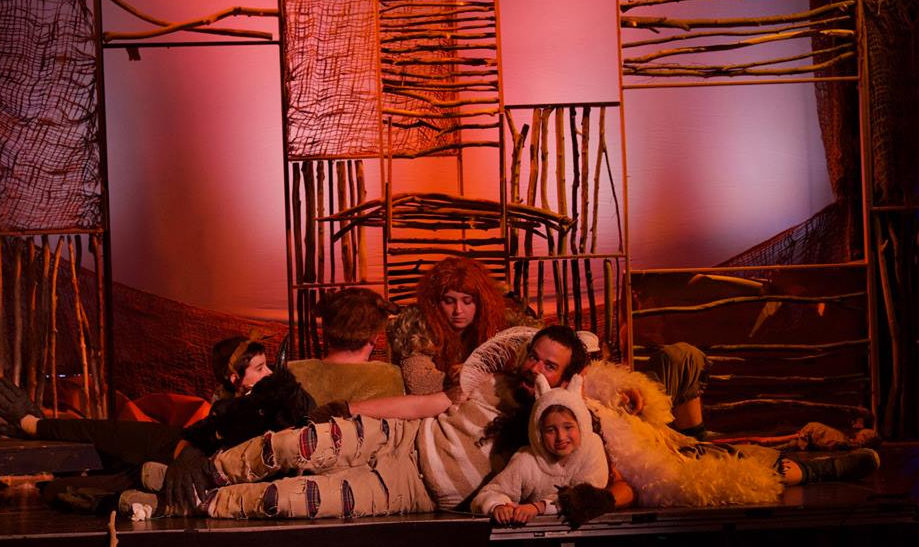
The Wild Things sleep in a comfy pile. – Photo by Bee Betley
Where the Wild Things Are, based on the iconic children’s picture book, packed the Garfield Center for the Arts last weekend with excited children and proud parents.
Directed by Bee Betley, the play follows a young boy, Max, who gets into trouble for being “out of control” after disrupting his family home while wearing his wolf costume. That night, Max is magically transported to a strange jungle where the Wild Things live – large, furry monsters with claws and horns. After they initially threaten to eat Max, the young boy frightens them, and they accept him as their king – a new experience for them. They celebrate with a “wild rumpus,” but as the night wears on, they begin to become unhappy with Max’s reign.
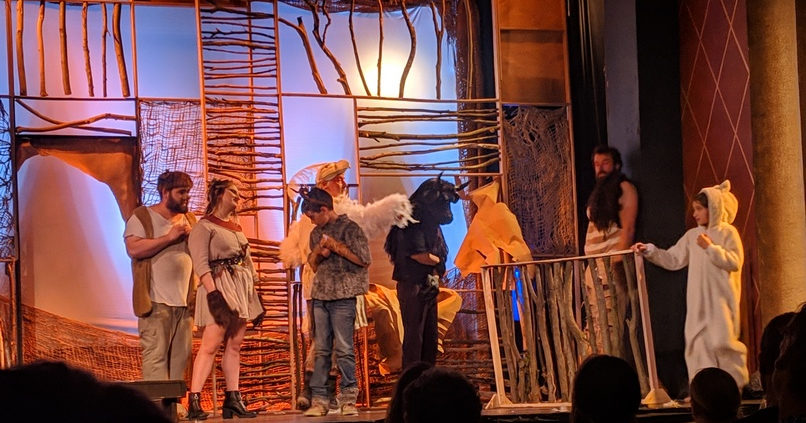
All the monsters engage in a “wild rumpus” with their new King Max. – Photo by Jane Jewell
The book, published in 1963, featured the author’s own illustrations — which he later said were based on caricatures of his aunts and uncles drawn when he was a young boy. It was recognized almost at once as a classic, being voted the prestigious Caldecott Medal as best children’s picture book of the year. And it has retained its appeal; in 2012 it was voted the best children’s picture book of all times by readers of School Library Journal. It has been adapted several times to other media, including an animated short film in 1973, an opera in 1980, and it was even parodied in an episode of “The Simpsons.”
Betley, whose previous directing credits at the Garfield include last year’s The Little Prince, said in her director’s note that she has always wanted to direct Wild Things. She notes how Max’s awareness of his identity develops as he tries to balance his authority as king of the Wild Things with the desire to please everyone and yet be in charge and get to do whatever he wants. And as Max quickly learns, the job is impossible.
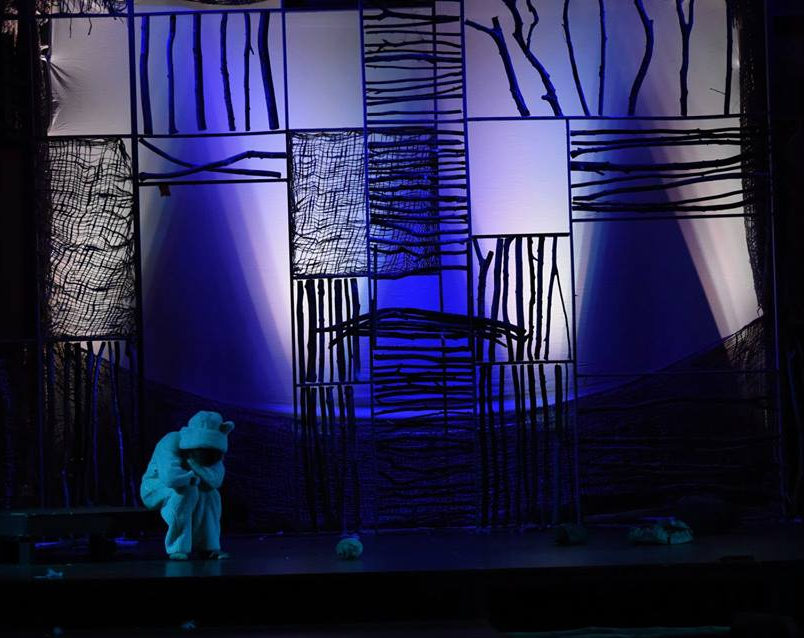
Max in a pensive mood – Photo by Bee Betley
The role of Max is key to the entire play, and Lydia Sensenig, acting in her first play, filled the role energetically, running around the stage, sometimes shrieking in frustration when Max can’t get the attention of his mother and sister. She effectively varies her tone, expressions, and body language in harmony with the character’s moods. An excellent job for a young actor, especially one who hasn’t previously been on stage.

John Mann as Carol, the wildest of the Wild Things – Photo by Bee Betley
John Mann, most recently seen in the GCA’s production of Mister Roberts, takes the role of Carol, one of the most powerful Wild Things. Max puts him in charge of building a fort, but Carol throws a tantrum when KW, another Wild Thing, wants to bring two owls she has befriended to the fort. Mann does a good job of showing Carol’s energy and quick changes of mood, projecting a sense of danger that echoes Max’s own anger.
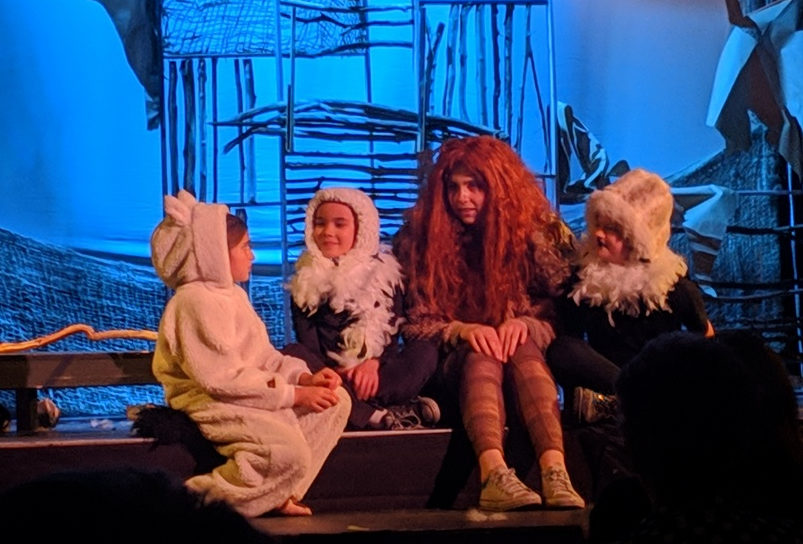
Max in his wolf costume talks with KW and the two owls, Bob and Terry. – Photo by Jane Jewell
KW is played by Georgia Rickloff, who has been a frequent performer in local theater since she played Tiny Tim in the GCA’s Christmas Carol in 2008. Her character, a loner who is often at odds with Carol, is in many ways the most sympathetic toward Max of all the monsters. Rickloff conveys KW’s softer side while at the same time remaining a convincing denizen of the monster realm.
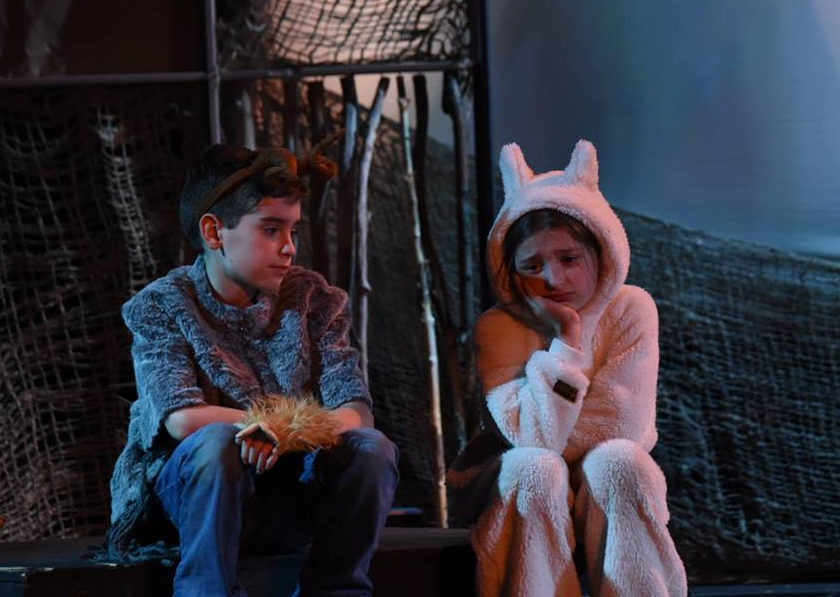
Brother and sister Aaron Sensenig and Lydia Sensinig as Alexander, a Wild Thing, and Max – Photo by Bee Betley
The other Wild Things are not as extreme in their emotions and actions as Carol, though each has their moments. Douglas, a Wild Thing with powerful arms who is something of a peace-keeper, is well played by Mike Heffron. Phebe Wood, a student at Gunston School, takes the role of Judith. Judith frequently argues with Carol and acts out when she doesn’t get her way. She can be loud and sometimes sarcastic but she, too, can show an unsure and insecure side, which may be why the more mild-mannered Wild Thing Ira, played by Zac Ryan, is her boyfriend. The two are “in love,” the other Wild Things tell Max. Aaron Sensenig (Lydia’s brother) plays Alexander, the youngest and smallest of the Wild Things. Paul Camberdella has two roles, as one of Max’s teachers and as a bull who lurks on the fringes of the Wild Things. The bull provides nice comic relief as he doesn’t speak but occasionally snorts or makes other funny noises. All do a good job in conveying a “family” who alternately laugh and play together, then sulk, argue, or run away.
Sarah Lyle, also acting in her first play, takes the role of Max’s mom. She shows the mother’s conflicting roles as she tries to give both Max and his sister the support and understanding that they each need while still dealing with her own problems of balancing a job and motherhood. Izzie Southworth is very believable as Max’s older sister, Claire. Claire is annoyed by her little brother who demands attention while she is on the phone or with her friends.
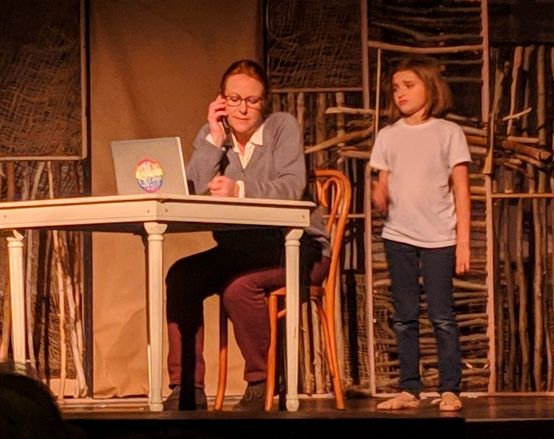
Max tries to get his mother’s attention while she is on an important phone call. – Photo by Jane Jewell
Alden Swanson and Zuzu Kusmider do a good job as the other children in Max’s life, at school, and as KW’s owl friends. The owls are especially funny as they answer questions and give advice, speaking at length in totally unintelligible chirps, squeaks, and squawks.
The very atmospheric music for the play was composed and performed on guitar by the director’s brother Seth Betley, who did a good job of matching the on-stage action with the mood of the music.
The set and costumes for the show, designed and constructed by Bee Betley, were imaginative and a lot of fun. The costumes went a long way toward giving the Wild Things – and Max – their distinctive characters. And the set’s open structure was visually effective while allowing the single setting to serve multiple purposes. The lighting, designed by Nic Carter, was a delightful display of chromatic virtuosity. The stage was washed with a full spectrum of colors; switching from bright orange to soft blue to pale violet, following the action and changing moods of the play.
This is a play about identity, family, friendship, and growing up. The Wild Things reflect the wild emotions we all feel – the anger, the jealousy, the insecurity, the need for acceptance, for attention, for love. All the things that make us human.
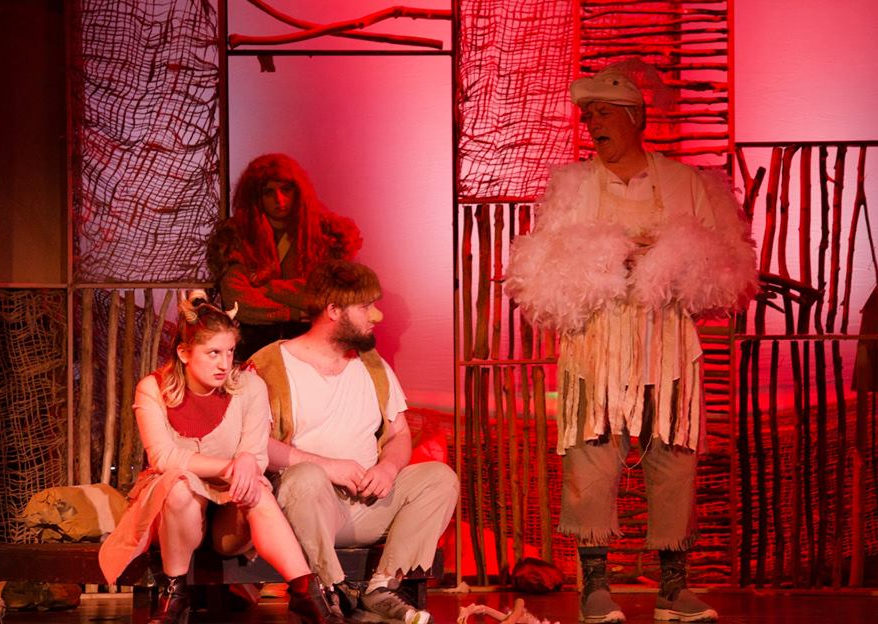
KW (in back) with Judith and Ira, the two lovers (seated) and Douglas of the mighty arms. – Photo by Bee Betley
Only two quibbles about this otherwise excellent production: the high number of minor scene changes, accompanied by blackouts, did slow the pace of the play somewhat. And occasionally, the dialogue was hard to understand – several other attendees we spoke to had the same observation. However, these did not detract from the overall enjoyment of the performance.
Where the Wild Things Are was a stimulating challenge for both cast and crew, and they definitely rose to the occasion. The performance we saw had a good number of younger audience members – all of whom seemed to enjoy the show as much as the adults. And once again, the performances were a reminder of the wealth of talent in the local community — a fact it is too easy to take for granted.
The production was one weekend only.
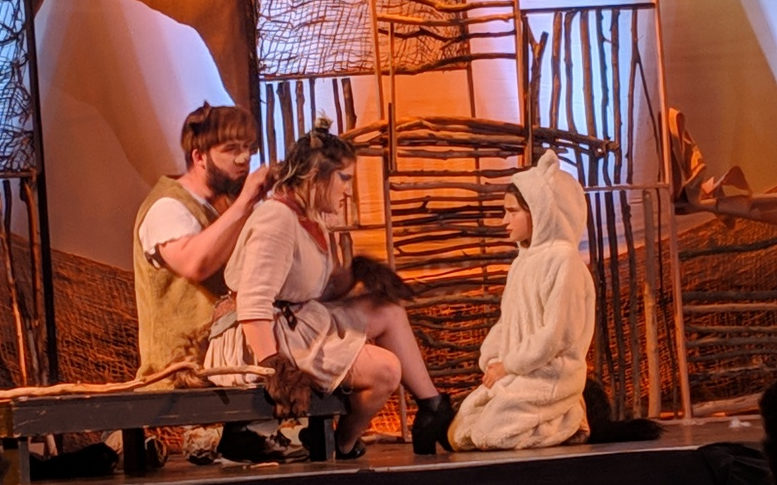
Ira, Judith, and Max – Photo by Bee Betley
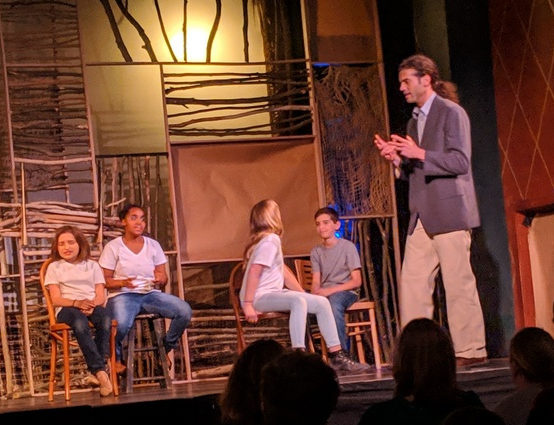
At school, they learn that the sun will die someday far in the future. – Photo by Jane Jewell
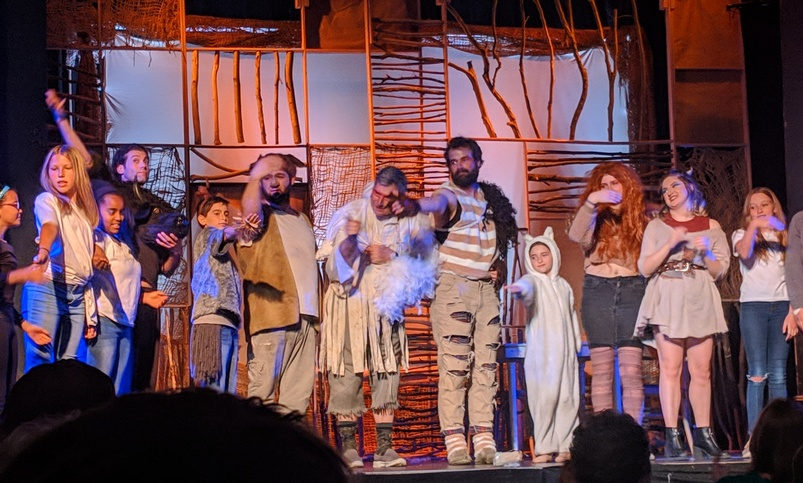
Curtain Call for “Where the Wild Things Are” – Photo by Jane Jewell
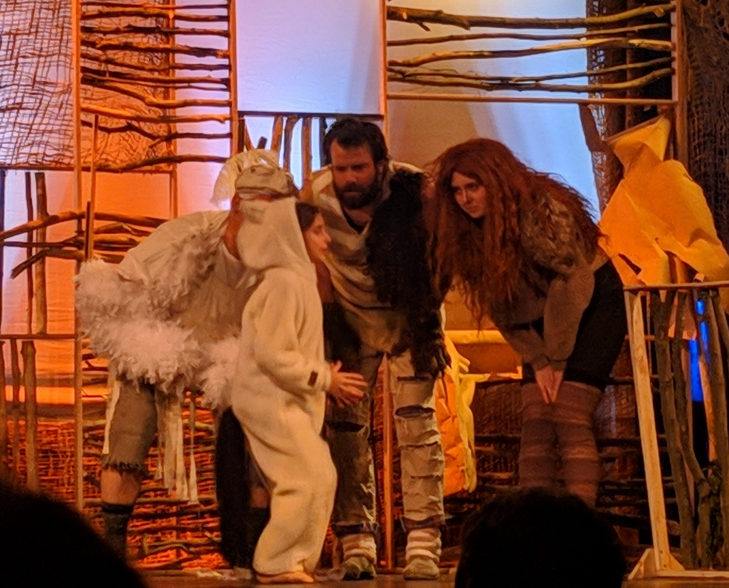
The Wild Things huddle with Max to make plans. – Photo by Jane Jewell
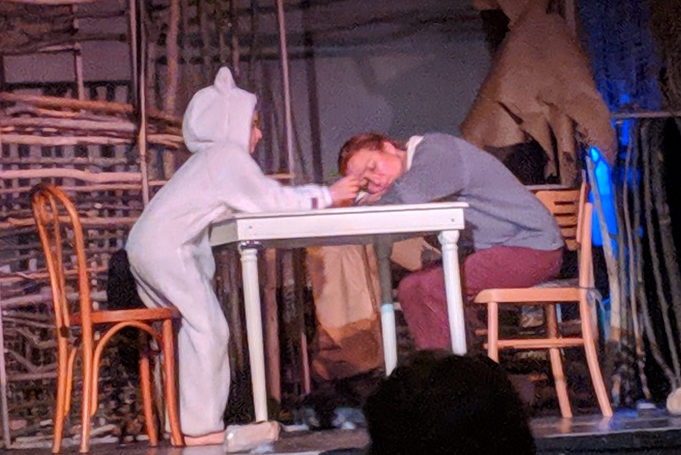
Max and his mother in a tender moment – Photo by Jane Jewell
###



Write a Letter to the Editor on this Article
We encourage readers to offer their point of view on this article by submitting the following form. Editing is sometimes necessary and is done at the discretion of the editorial staff.